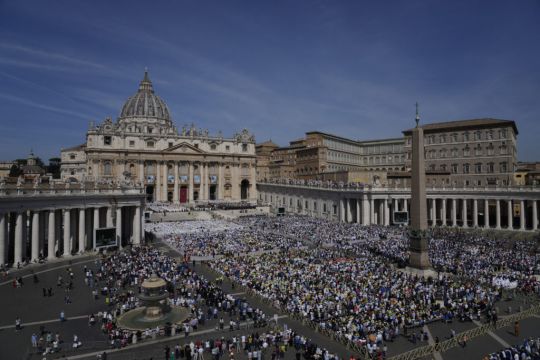Pope Francis created 10 new saints on Sunday, rallying from knee pain that has forced him to use a wheelchair to preside over the first canonisation ceremony at the Vatican in more than two years.
Francis stood for a long period at the start of the ceremony to greet priests concelebrating the Mass, and hobbled on to the altar to proclaim the six men and four women saints.
They include a Dutch priest-journalist who was killed by the Nazis, a lay Indian convert who was killed for his faith, and half-a-dozen French and Italian priests and nuns who founded religious orders.

Francis told the crowd of an estimated 45,000 in St Peter’s Square that the 10 embodied holiness in everyday life, and said the church needs to embrace this idea rather than an unattainable ideal of personal achievement.
“Holiness does not consist of a few heroic gestures, but of many small acts of daily love,” he said from his chair on the altar.
Francis has been complaining of strained ligaments in his right knee for months and has recently been seen using a wheelchair at public audiences.
Sunday’s ceremony was evidence that Francis is still able to walk, but he appears to be taking it as easy as possible to let the ligaments heal before an intense period of travel starting in July.
The Vatican has confirmed two trips that month, one to Congo and South Sudan and one to Canada.

It was the first canonisation Mass at the Vatican since before the coronavirus pandemic and, aside from Easter celebrations last month, it drew one of the biggest crowds in St Peter’s Square in recent times.
The Italian president, Dutch foreign minister, French interior minister and the minister for minorities of India were among those packed in the sunny piazza, which was adorned with Dutch flowers in honour of the Rev Titus Brandsma, a martyr saint who was killed at the Dachau concentration camp in 1942.
In the run-up to the canonisation, a group of Dutch and German journalists formally proposed that Rev Brandsma become a co-patron saint of journalists, alongside St Francis de Sales, given his work to combat propaganda and fake news during the rise of fascism and Nazism in Europe.
According to an open letter sent to Francis this month, the journalists noted that Rev Brandsma successfully argued for a ban on printing Nazi propaganda in Catholic newspapers.
There has been no immediate response from the Pope.

In addition to Rev Brandsma, the new saints include the 18th-century Indian convert Lazarus, known also as Devashayam, who mixed with India’s lower castes and was considered treasonous by India’s royal palace, which ordered him arrested and executed in 1752.
“He is for the poor people,” said Arachi Syril, an Indian pilgrim from Kanyakumari who was in the square for the Mass. “He hated the caste system, still it is going on, but he is the martyr for that.”
Also canonised was Cesar de Bus, a French priest who founded the Fathers of Christian Doctrine religious order and died in 1607; Luigi Maria Palazzolo, an Italian priest who cared for orphans and died in 1886; Giustino Maria Russolillo, an Italian priest who founded a religious order dedicated to promoting religious vocations and died in 1955; and Charles de Foucauld, a French missionary who, after rediscovering his faith as a young man, decided to live among the Tuareg peoples in the Algerian Sahara and was killed in 1916.
The four nuns are: Marie Rivier, who overcame a sickly childhood in France to become a nun and found a religious order and died in 1838; Maria Francesca di Gesu Rubatto, an Italian nun who helped found a religious order and died in 1904 in Montevideo, Uruguay; and Italians Maria di Gesu Santocanale and Domenica Mantovani, who founded religious orders and died in 1923 and 1934 respectively.







